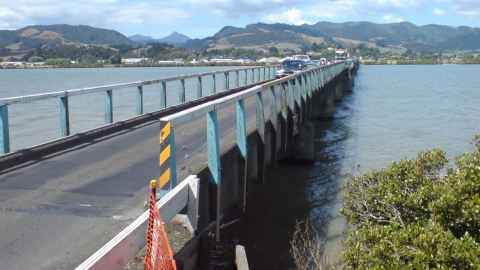Recycling heritage at the Kopu Bridge
6 April 2018
Opinion: To Coromandel holiday-makers the old Kopu bridge was synonymous with long traffic queues - but a determined community group sees it as so much more.

Who’d look after an old bridge? Even worse, who’d want to be responsible for one? Last month, Cyclone Gita carried away fifty metres of the Pyramid Bridge in Southland. Late last year, the historic timber Ngatiawa Bridge east of Waikanae collapsed into the river below. Both bridges date from the first decades of the 1900s.
Old bridges face difficult problems with maintenance, safety and fitness for purpose. And yet, near Thames, a community group is taking charge of the historic Kopu Bridge, which first opened to traffic in 1928.
The Kopu Bridge and Community Trust took over management of the bridge from the New Zealand Transport Agency (NZTA) on March 18, after than six years of negotiations and uncertainty over its future. The Trust’s victory was the result of collaboration with a range of interested parties, including local councils and residents as well as Heritage New Zealand.
So what exactly has the Trust taken on?
If you holidayed in the Coromandel before 2011, you’d know the Kopu Bridge. Or at least, you’d remember the long queues of cars waiting for their turn to cross its narrow one-lane spans. On the new two-lane bridge you zoom across the Waihou River barely noticing the old one below.
Despite being labelled an “eyesore” by Coromandel MP Scott Simpson and with others calling for its removal, the Trust is determined to save what is the last surviving example of a swing-span bridge in New Zealand. They say it’s an “asset to the community” and a “drawcard.” Heritage New Zealand and Engineering New Zealand share that view: both consider it an important part of the country’s history. A nation of rivers is a nation of bridges, and building the Kopu Bridge was a mighty challenge.
The Waihou River bottom is soft, muddy and treacherous. To support the deck, engineers split the bridge into 25 separate spans, sinking piles as deep as seventy feet into the riverbed to hold up the piers. At that length, piles had to be timber at the bottom because the concrete piles of the day wouldn’t have handled the pummeling. Once installed, the piles were cased in concrete tubes to protect them from passing logs, fish, and taniwha.
The shift from the passenger vehicle to bicycle might form part of the next chapter of the bridge’s story.
Make that the Taniwha. As in the steamer which helped transport butter exports when the Hauraki Plains were opened up to dairy farming after 1908. To let the ships through, the bridge incorporates a nifty mechanism known as a swing span.
This was how it worked. Stand in the middle of the room, your arms outstretched. You’re the bridge. The water’s coming towards you. To let the ships through, you pivot around at the waist, your arms pointing upstream and down. Everything’s balanced around your feet, the central pier. The engineers managed a clear fifty-foot gap based on this principle, so that when the spans swung open, the steamers could sail through. The gap wasn’t always big enough for the Tuhoe and the Taniwha, which clobbered the bridge in 1927 and 1928 respectively.
What might the Trust do with the bridge now they’ve got it? According to NZTA, even after 90 years of straddling a wide and swift-flowing river, the bridge is sound. There’s some work that needs doing right away, like handrail repairs. The terms of the agreement with NZTA gives the Trust a five-year period to manage the bridge, during which time they can hand it back if they feel that they can’t maintain it.
One answer may lie in repurposing the historic bridge for a new use. The Trust would like to open it to walkers and cyclists, since it sits on the route of the Hauraki Rail Trail. It might also be a pretty handy spot for fishing.
The bridge might end up forming part of a wider cycleway scheme through the Thames district. Historic buildings and structures become beloved when they offer something useful and relevant to the local community, as well as to visitors from further afield. The stories that go along with the structures can be part of what attracts people to ride the route, those stories are what visitors take home with them. Historical patterns of rise and decline for both river and road transport define the bridge’s social significance. Today’s nationwide emphasis on the shift from the passenger vehicle to bicycle might form part of the next chapter of the bridge’s story.
Heritage conservation might be compared to bridge-building. It can be expensive, technical, and risky. But it’s also a fundamentally hopeful pursuit, in which passionate people take on a challenge on behalf of a future they won’t live to see. If the Trust can manage to integrate the Kopu Bridge back into the life of the community, expect your grandchildren to see it still gamely straddling the Waihou in another ninety years, linking past and present.
Hamish Tocher is a third-year Bachelor of Engineering student at the University of Auckland.
Stacy Vallis is a PhD student at Auckland University’s School of Architecture and Planning.
This article reflects the opinion of the authors and not the views of the University of Auckland.
Used with permission from Newsroom, Recycling heritage at the Kopu Bridge, published on 25 May 2018.